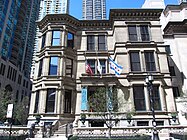File:A Wanderer in the Elysian Fields - Charlotte Wylie.jpg

Original file (424 × 960 pixels, file size: 118 KB, MIME type: image/jpeg)
Captions
Captions
Summary[edit]
| Charlotte Wylie: A Wanderer in the Elysian Fields
|
|||||||||||||||||||||
|---|---|---|---|---|---|---|---|---|---|---|---|---|---|---|---|---|---|---|---|---|---|
| Artist |
Charlotte Wylie (1828-1909) |
||||||||||||||||||||
| Title |
A Wanderer in the Elysian Fields label QS:Len,"A Wanderer in the Elysian Fields" |
||||||||||||||||||||
| Object type |
painting object_type QS:P31,Q3305213 |
||||||||||||||||||||
| Description |
A classically-dressed adolescent holding a branch of roses walks through a dimly-lit landscape, with huge lilies behind her. |
||||||||||||||||||||
| Date |
1886 date QS:P571,+1886-00-00T00:00:00Z/9 |
||||||||||||||||||||
| Medium |
oil on canvas medium QS:P186,Q296955;P186,Q12321255,P518,Q861259 |
||||||||||||||||||||
| Dimensions |
height: 49.2 in (125 cm); width: 23 in (58.4 cm) dimensions QS:P2048,49.25U218593 dimensions QS:P2049,23U218593 |
||||||||||||||||||||
| Collection |
|
||||||||||||||||||||
| Object history |
11 June 2004: purchased by The Richard H. Driehaus Museum at an anonymous sale at Christie's (auction house), lot no. 102, for £35,850 |
||||||||||||||||||||
| Exhibition history | Exhibited at the Grosvenor Gallery in 1886 | ||||||||||||||||||||
| Inscriptions | Signed "C. Wylie" in lower right | ||||||||||||||||||||
| Notes |
The present picture .... was the last of the ten pictures that [Wylie] showed at the Grosvenor Gallery, appearing there in 1886 and being illustrated in Henry Blackburn's Grosvenor Notes. This is fortunate, enabling us to identify a work that seems to have received no critical attention. In fact no review of any picture by Wyllie has yet been traced. The Elysian fields were the abode of the blessed in classical mythology, so the subject of the picture is presumably a soul in heaven. The image confirms Wyllie's feeling for symbolism and particularly her interest in the symbolism of flowers, in this case roses and lilies. Flowers clearly played a prominent part in three of her other Grosvenor exhibits, even though we only know them by name: Rosa Mystica (1880), Roses (1882) and Calliope: A Portrait with Flowers (1884). The picture could hardly be more characteristic of the Grosvenor ethos. The colouring is very Aesthetic, instantly recalling the famous phrase 'greenery yallery, Grosvenor Gallery' to which W.S. Gilbert had given currency in the comic opera Patience, his satire on the Aesthetic craze first staged in 1881. There are also obvious echoes of Burne-Jones, the undisputed star of the Grosvenor since its opening in 1877. The gentle, high-souled mood, the flower symbolism, the androgynous type, the fluttering or finely-pleated drapery, the circlet of flowers at the neck - all these betray his influence. In fact the figure has almost been lifted from The Days of Creation (Fogg Museum of Art, Harvard), one of the eight large pictures with which he had made such an overwhelming impression in 1877. Wyllie would not only have seen the work Burne-Jones showed at the Grosvenor but probably met him there too - it was a very social organisation, famous for its receptions. She may even have enjoyed the sort of relations with him that she did with Watts. Whatever the case, Wyllie was clearly an eclectic artist, looking at a number of sources. In the light of our picture, it is not surprising that she had 'considerable knowledge of the methods employed by the old masters', and used to discuss them with Watts. There is a distinctly 'old mastery' feel to the picture in terms of tone, touch, and such details as the spray of roses. Watts himself is not far away either, especially in the dry and crumbly nature of the paint. In fact the picture could be described as a Burne-Jonesian vision seen through the medium of the old masters and Watts. All in all, the picture is a fascinating discovery which amply bears out Mary Watts's comment that Wyllie 'possessed a fine artistic gift'. It suggests that she was one of the best of the many women artists that were fostered by the Grosvenor, and we can only regret that parental discouragement, marital commitments and, surely, lack of critical recognition, combined to limit her production so severely. |
||||||||||||||||||||
| References | Christie's | ||||||||||||||||||||
| Source/Photographer | Female Artists in History | ||||||||||||||||||||
Licensing[edit]
|
This is a faithful photographic reproduction of a two-dimensional, public domain work of art. The work of art itself is in the public domain for the following reason:
The official position taken by the Wikimedia Foundation is that "faithful reproductions of two-dimensional public domain works of art are public domain".
This photographic reproduction is therefore also considered to be in the public domain in the United States. In other jurisdictions, re-use of this content may be restricted; see Reuse of PD-Art photographs for details. | |||||
File history
Click on a date/time to view the file as it appeared at that time.
| Date/Time | Thumbnail | Dimensions | User | Comment | |
|---|---|---|---|---|---|
| current | 06:29, 3 November 2019 |  | 424 × 960 (118 KB) | Levana Taylor (talk | contribs) | User created page with UploadWizard |
You cannot overwrite this file.
File usage on Commons
The following page uses this file:
File usage on other wikis
The following other wikis use this file:
- Usage on et.wikipedia.org
- Usage on et.wikiquote.org
- Usage on www.wikidata.org
Metadata
This file contains additional information such as Exif metadata which may have been added by the digital camera, scanner, or software program used to create or digitize it. If the file has been modified from its original state, some details such as the timestamp may not fully reflect those of the original file. The timestamp is only as accurate as the clock in the camera, and it may be completely wrong.
| JPEG file comment | * |
|---|

